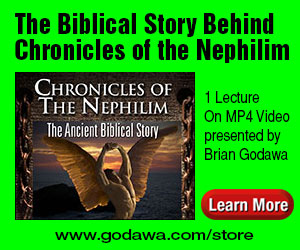In the last two posts (here and here), we looked at the ancient Greek picture of Hades, the abode of the dead, and what hell really was in Hebrew thinking. It wasn’t the immediate pit of flames upon death. We compared it with the Biblical picture which was both similar and very different. The Old Testament used the word Sheol for the abode of the dead, the New Testament used Hades, and Tartarus. Gehenna was a special valley in Jerusalem that was a metaphor for future judgement.
Hades in the Book of Enoch
Apart from Jesus’ parable of Abraham’s Bosom (Luke 16:19-31), there are no descriptions of the actual geography of the underworld in the New Testament. Rather than drawing from pagan Greek myths to depict Hades in Jesus Triumphant, I decided to draw from a respected Jewish source that did provide a “cosmic geography” or conceptual map of the universe that included the underworld. This geography of Hades can be found in the visions of the ancient book of 1Enoch.[1]
Though 1Enoch is not Scripture, I have argued elsewhere for the high regard that the New Testament gives the ancient text as a source for some of its own theological concepts and language.[2] The book consists of several “books,” that recount an expanded version of the Genesis 6 story of the Watchers and Nephilim giants, as well as visions that the prophet Enoch allegedly experienced of angels taking him around the earth, up into the heights of heaven, and down into the depths of Hades (which are actually arrived at by going to the “ends of the earth” rather than descending down into the earth).
Unfortunately, these visions are obscure, overlapping, and at times contradictory, so scholars have disagreed over their interpretation as well as their actual cosmic geography. I have attempted to use my own reading of the text and integrate it with several of these scholarly viewpoints that can be found analyzed in the book, A Study of the Geography of 1 Enoch 17-19, by Kelley Coblentz Bautch.[3] Imagination is required!
Since Enoch’s “map” is cosmic, it includes Sheol/Hades as well as the heavens and the earth. But some scholars have argued that Enoch’s entire journey is to the realm of the dead.[4] So I decided to use the ancient Near Eastern (and Jewish) notion of “on earth as it is in heaven” (Matt. 6:10) or “as above, so below,” to apply to the underworld as well.
In this way, the geography of Hades that Jesus follows on his underworld journey, is a reflection of the sacred geography of the earth above (“Sacred geography” means that it does not so much follow physical geography as it does theological meaning).
Since the underworld was believed by the Jews to be under the earth,[5] and accessed by the waters of the Abyss,[6] that was the source of the waters above,[7] I have those waters work as a kind of sky in the dome of the underworld (though not in all places).
The mountains below rise up from Hades to the earth above. So when Jesus is at Mount Zion in Hades, it rises up and penetrates the ceiling of Hades and becomes Mount Zion on earth above them. This fulfills the ancient Near Eastern notion of the cosmic mountains being an axis mundi, a connection between the heavens, the earth, and the underworld.[8]
The circle of Hades matches the circle of the earth above it and likewise has an ocean/river (the Great Sea or Abyss) at its outer reaches that extends beyond the “Four Winds” or “Four Corners” of the earth where the pillars of the earth support the heavens and the earth (1En. 17:5; Prov. 8:27, 29; 1Sam. 2:8; Mark 13:27).[9]
 In this conceptual map, Jerusalem, or Mount Zion is at the center of the earth, and has “the accursed valley” (Gehenna) right next to it (Ezek. 5:5, 38:12; 1En. 26:1-2; 27:2).
In this conceptual map, Jerusalem, or Mount Zion is at the center of the earth, and has “the accursed valley” (Gehenna) right next to it (Ezek. 5:5, 38:12; 1En. 26:1-2; 27:2).
North from that center resides Mount Hermon, the “rock” (mountain) that Jesus said God would build his new kingdom church upon.[10] This mountain is described as “reaching to the heavens” and as being the celestial storehouse of the luminaries and storms (1En. 17:3). Many rivers flow from it, including a river of fire and a river of “living waters” (17:4-8), and it is guarded by fiery beings who take human shape (17:1). This “source of the waters” is a reflection of the cosmic Mountain of Eden and it’s source of living waters (Ezek. 28:13-14).[11]
In the south are seven mountains of precious stones arranged in a perpendicular layout. The central mountain burns with fire day and night, and is called the “throne of God,” where God will come down at the final judgment. These elements suggest it is Mount Sinai (1En. 24-25).
In the west are “wintery winds” and the “great darkness,” where another mountain hosts “hollow places” for the souls of all the dead. The righteous are separated from the sinners, much like the chasm separates the righteous in Abraham’s Bosom from the sinners in the parable of Lazarus. (Luke 16:19-26; 1En. 17:6; 22:1-14).
In the east are “great beasts and birds” at the ends of the earth (1En. 33:1). Tartarus is further “beyond the edge of the earth,” where the earth meets to uphold the vault of heaven (1En. 18:10).[12] This is where the angels who sinned in Genesis 6 are kept imprisoned in gloomy darkness (2Pet. 2:4; 1Pet. 3:18-20). They are in deep pits or chasms that are like fiery pillars. (1En. 18:10-16).
There is much more detail that can be quite confusing to follow, so I have included an illustrated map with some of the major elements adapted from Bautch and my own reading of 1Enoch.

Can We Trust This Ancient Cosmology?
The ancient Biblical cosmic picture is a three-tiered universe with God’s throne above the waters of heaven, a solid dome above the flat disc earth, founded on pillars, surrounded by a circular sea, on top of a watery abyss, beneath which is the underworld of Sheol, where souls are trapped in waiting cells for a final judgment.[13]
A natural question arises while examining this ancient cosmology: If the Biblical writers were so “scientifically inaccurate” in their understanding of the universe, then why should we trust what they write about God, the afterlife, and judgment?
Some well-intentioned Evangelicals seek to maintain their particular definition of Biblical inerrancy by denying that the Bible contains this ancient Near Eastern cosmography. They try to explain it away as phenomenal language or poetic license. Phenomenal language is the act of describing what one sees subjectively from one’s perspective without further claiming objective reality.
So when the writer says the sun stood still, or that the sun rises and sets within the solid dome of heaven, he is only describing his observation, not cosmic reality. The claim of observation from a personal frame of reference is certainly true as far as it goes. Of course the observer describes what they are observing. But the distinction between appearance and reality is an imposition of our alien modern understanding onto theirs. As Seely explains,
“It is precisely because ancient peoples were scientifically naive that they did not distinguish between the appearance of the sky and their scientific concept of the sky. They had no reason to doubt what their eyes told them was true, namely, that the stars above them were fixed in a solid dome and that the sky literally touched the earth at the horizon. So, they equated appearance with reality and concluded that the sky must be a solid physical part of the universe just as much as the earth itself.”[14]
If the ancients did not know the earth was a sphere in space, or that there was no underworld beneath their feet, they could not know that their observations of appearances were anything other than reality.
 It would be easy enough to relegate one or two examples of Scripture to the notion of phenomenal language, but when dozens of those phenomenal descriptions reflect the same complex integrated picture of the universe that Israel’s neighbors shared, and when that picture included many elements that were not phenomenally observable, such as the Abyss, Sheol, or the pillars of earth and heaven, it strains credulity to suggest these were merely phenomenal descriptions intentionally unrelated to reality. If it walks a like an ancient Near Eastern duck and talks like an ancient Near Eastern duck, then chances are they thought it was an ancient Near Eastern duck, not just the “appearance” of one having no reality.
It would be easy enough to relegate one or two examples of Scripture to the notion of phenomenal language, but when dozens of those phenomenal descriptions reflect the same complex integrated picture of the universe that Israel’s neighbors shared, and when that picture included many elements that were not phenomenally observable, such as the Abyss, Sheol, or the pillars of earth and heaven, it strains credulity to suggest these were merely phenomenal descriptions intentionally unrelated to reality. If it walks a like an ancient Near Eastern duck and talks like an ancient Near Eastern duck, then chances are they thought it was an ancient Near Eastern duck, not just the “appearance” of one having no reality.
It would be a mistake to claim that there is a single monolithic ancient Near Eastern cosmography.[15] There are varieties of stories with overlapping imagery, and some contradictory notions. But there are certainly enough commonalities to affirm a generic yet mysterious picture of the universe. And that picture in Scripture undeniably includes poetic language. The Hebrew culture was imaginative. They integrated poetry into everything, including their observational descriptions of nature.
Thus a hymn of creation such as Psalm 19 tells of the heavens declaring God’s glory as if using speech, and then describes the operations of the sun in terms of a bridegroom in his chamber or a man running a race. Creative imagination is inescapable and ubiquitous.
And herein lies a potential solution for the dilemma of the scientific imprecision of the ancient cosmic geography in Scripture: The Israelite culture, being pre-scientific, thought more in terms of function and purpose than material structure. Even if their picture of the heavens and earth as a three-tiered geocentric cosmology, was scientifically “false” from our modern perspective, it nevertheless still accurately describes the teleological purpose and meaning of creation that they were intending to communicate.
Though there is no literal underworld beneath the earth with rivers of fire and souls trapped in mountains waiting for the judgment, it still communicates the truth, transcendent of that ancient culture yet revealed through it, that those who have died await a future resurrection and judgment before the living God.
Jesus’ descent into that imaged underworld is a theological narrative explaining the transcendent truth that his death and resurrection paid the price for the sins of his people, and secured his victory over the spiritual powers who rule mankind, and from whom Christ has taken back his inheritance of the earth.
Our modern worldview obsessed as it is with empirical science and human reason is so blinded to its own ignorance of transcendent reality and stunted imagination, that it amounts to idolatry, the limited, fallible human mind and senses as god.
John Walton has written recently of this ANE concern with powers over structure in direct relation to the creation story of Genesis. He argues that in the ancient world existence was understood more in terms of function within a god-created purposeful order than in terms of material status within a natural physical structure.[17]
This is not to say that the physical world was denied or ignored, but rather that the priority and interests were different from our own. We should therefore be careful in judging their purpose-driven cosmography too strictly in light of our own material-driven cosmography. And in this sense, modern material descriptions of reality are more “false” than ancient pictures because they do not include the immaterial aspect of reality: Meaning and purpose.
But even more basic than that, human observation of the universe is always changing, from Newtonian physics to Quantum physics to String Theory. That change is less a change of more precise instrumentation than it is a change of ideas. What we think we see is more affected by our philosophical presuppositions (and theories) than empirical scientists are willing to admit.
Biblical writers did not teach their cosmography as scientific doctrine revealed by God about the way the physical universe was materially structured, they assumed the popular cosmography to teach their doctrine about God’s purposes and meaning.
To critique the cosmic model carrying the message is to miss the meaning altogether, which is the message. God’s throne may not be physically above us in waters held back by a solid firmament, but he truly does rule “over” us from another dimension, and is king and sustainer of creation in whatever model man uses to depict that creation. The phrase “every created thing which is in heaven and on the earth and under the earth” (Rev. 5:13) is equivalent in meaning to the modern concept of every particle and wave in every dimension of the Big Bang space-time continuum, as well as every person dead or alive.
The geocentric picture in Scripture is a depiction through man’s ancient perspective of God’s purpose and humankind’s significance. For a modern heliocentrist to attack that picture as falsifying the theology would be cultural imperialism. Reducing significance to physical location is simply a prejudice of material priority over spiritual purpose.
One of the humorous ironies of this debate is that if the history of science is any judge, a thousand years from now, scientists will no doubt consider our current paradigm with which we judge the ancients to be itself fatally flawed. This is not to reduce reality to relativism, but rather to illustrate that all claims of empirical knowledge contain an inescapable element of human fallibility and finitude. A proper response should be a bit more humility and a bit less hubris regarding the use of our own scientific models as standards in judging theological meaning or purpose.
For additional Biblical and historical research related to this novel, go to www.ChroniclesoftheNephilim.com under the menu listing, “Links” > Jesus Triumphant.


2 comments on “The Geography of Hades”
Very informative ! I’ve studied Biblical prophecy for years and the subject of hell, hades, is confusing to some ! Really enjoined your article!
Excellent article and well done to articulate the key difference between modern view (structure) and the ancient view (purpose, function)
Comments are closed.